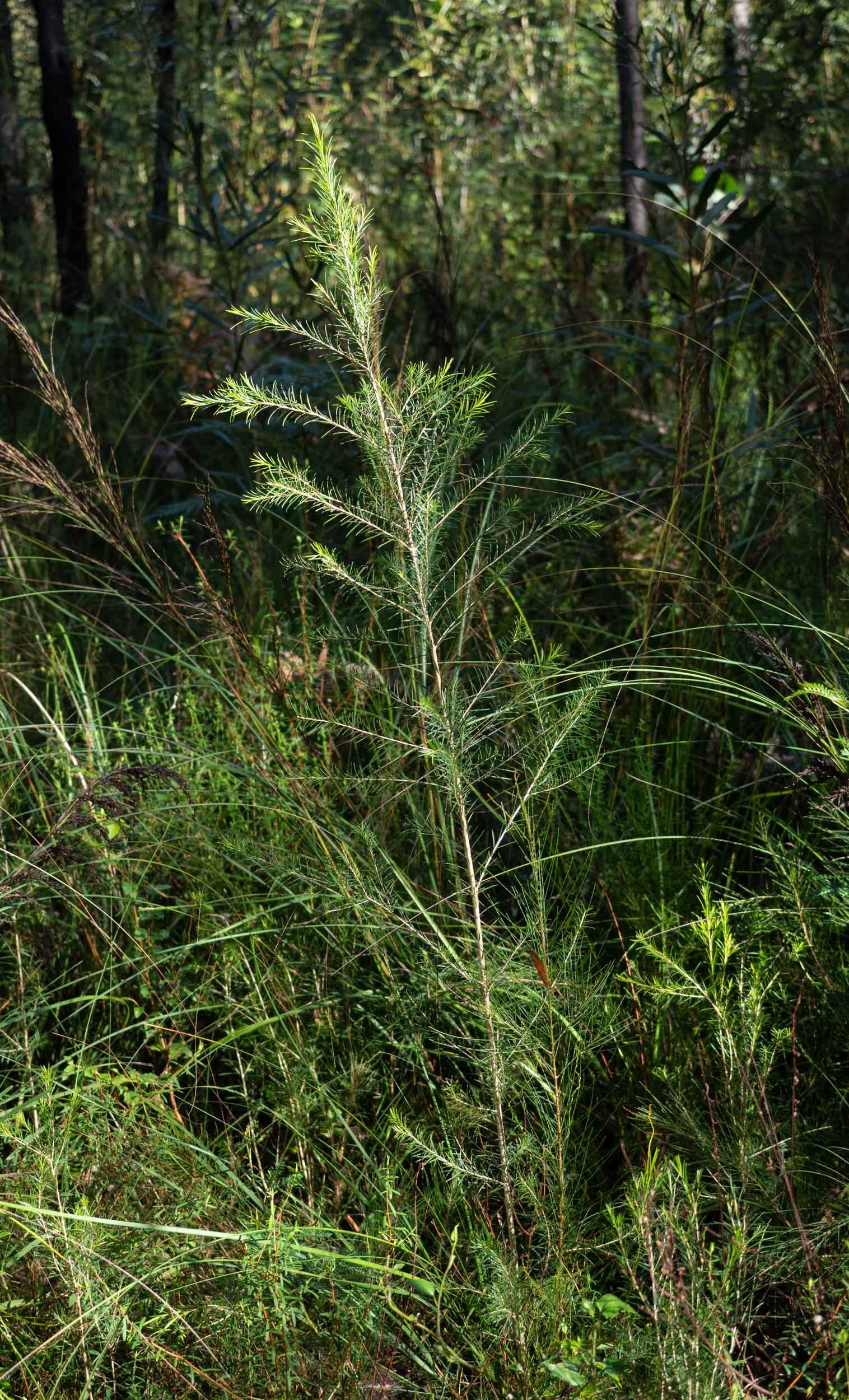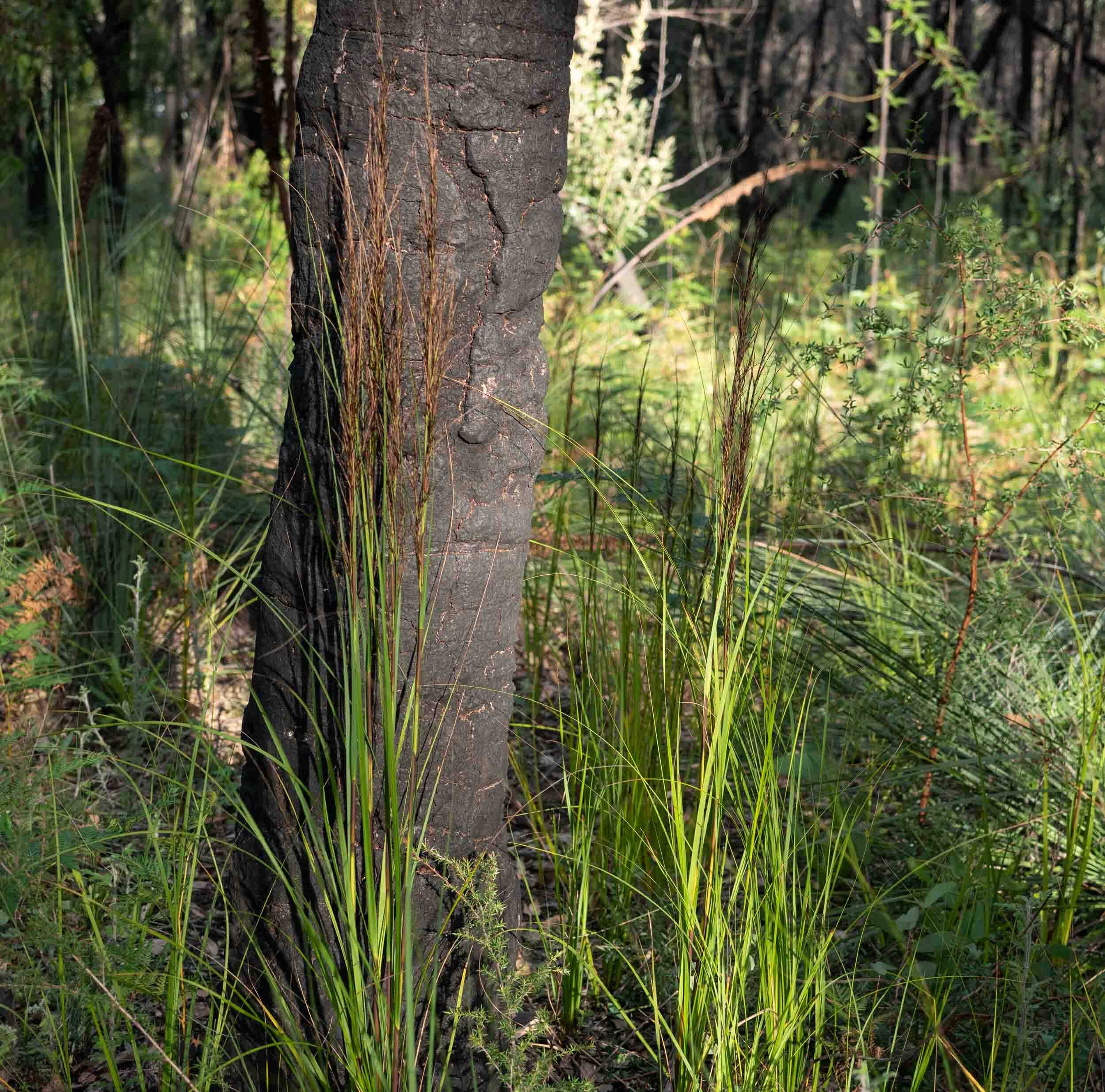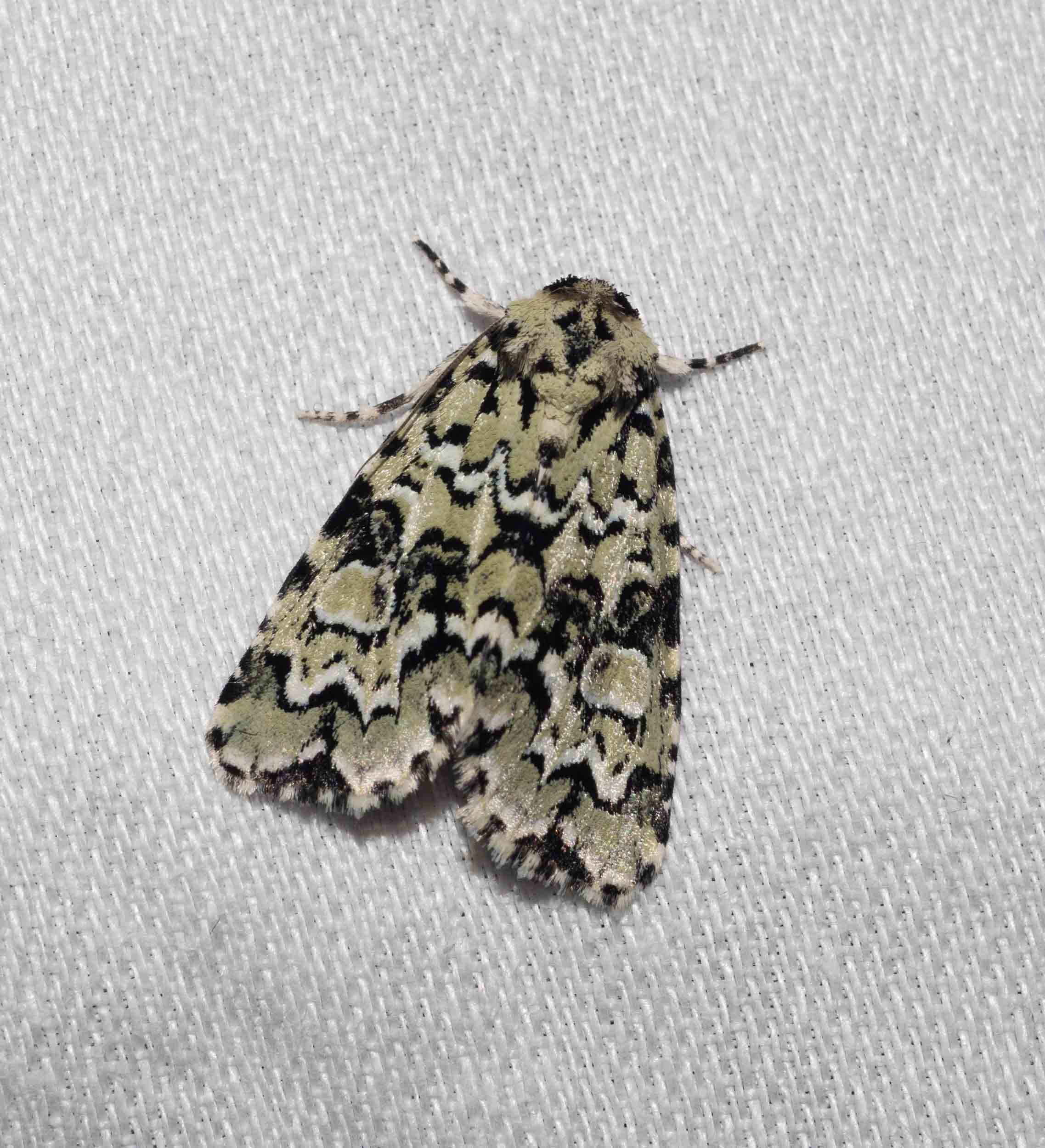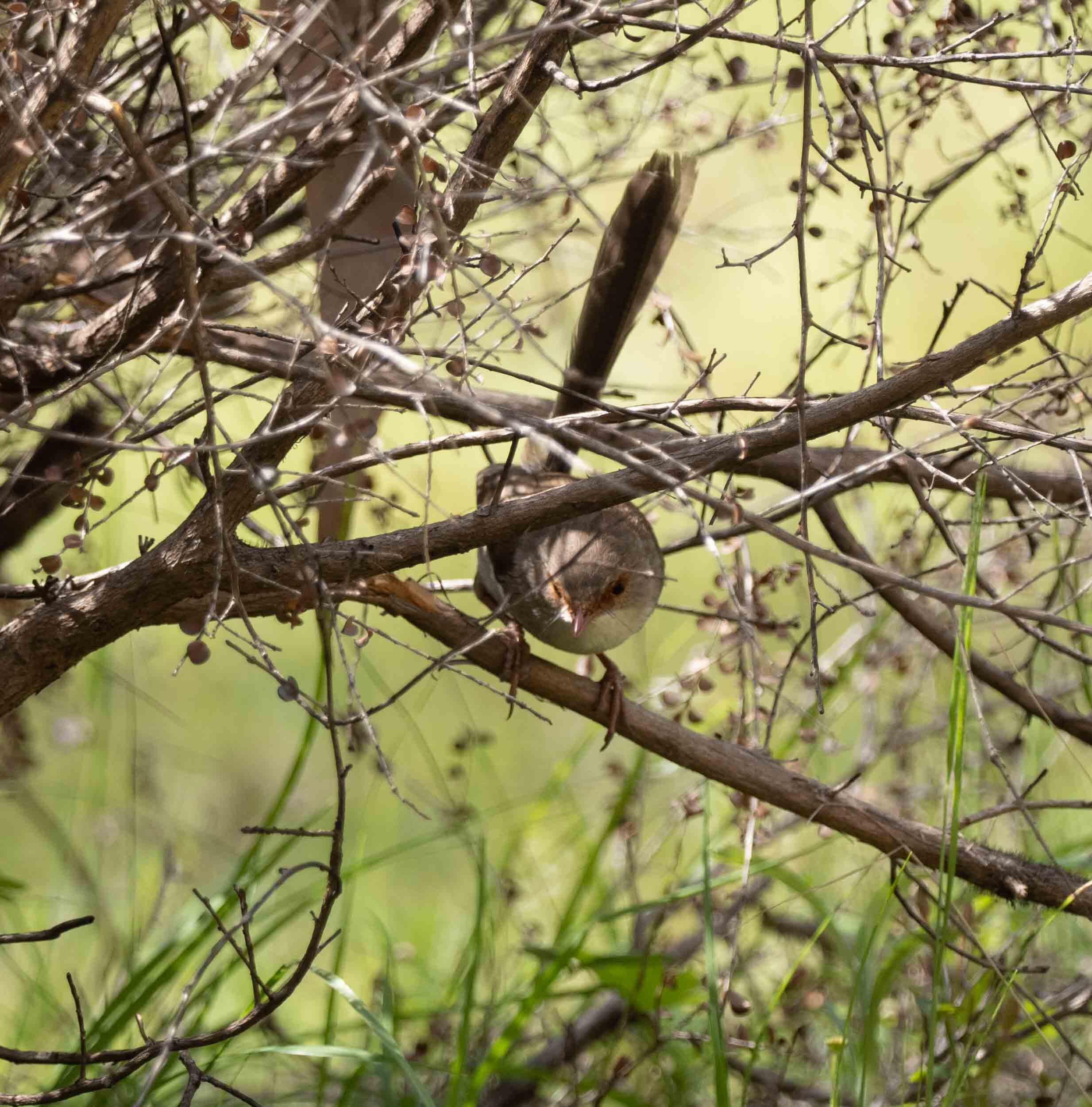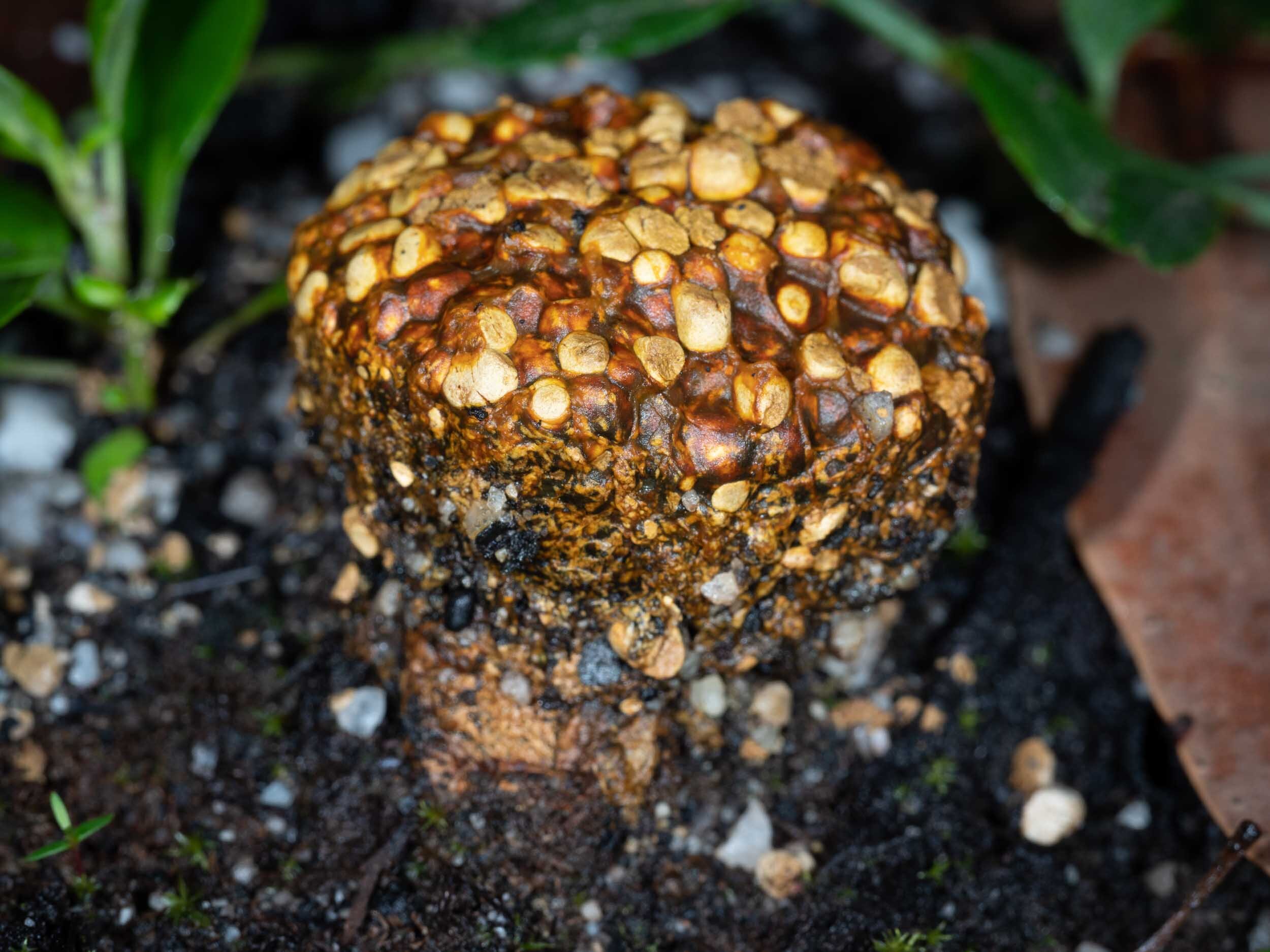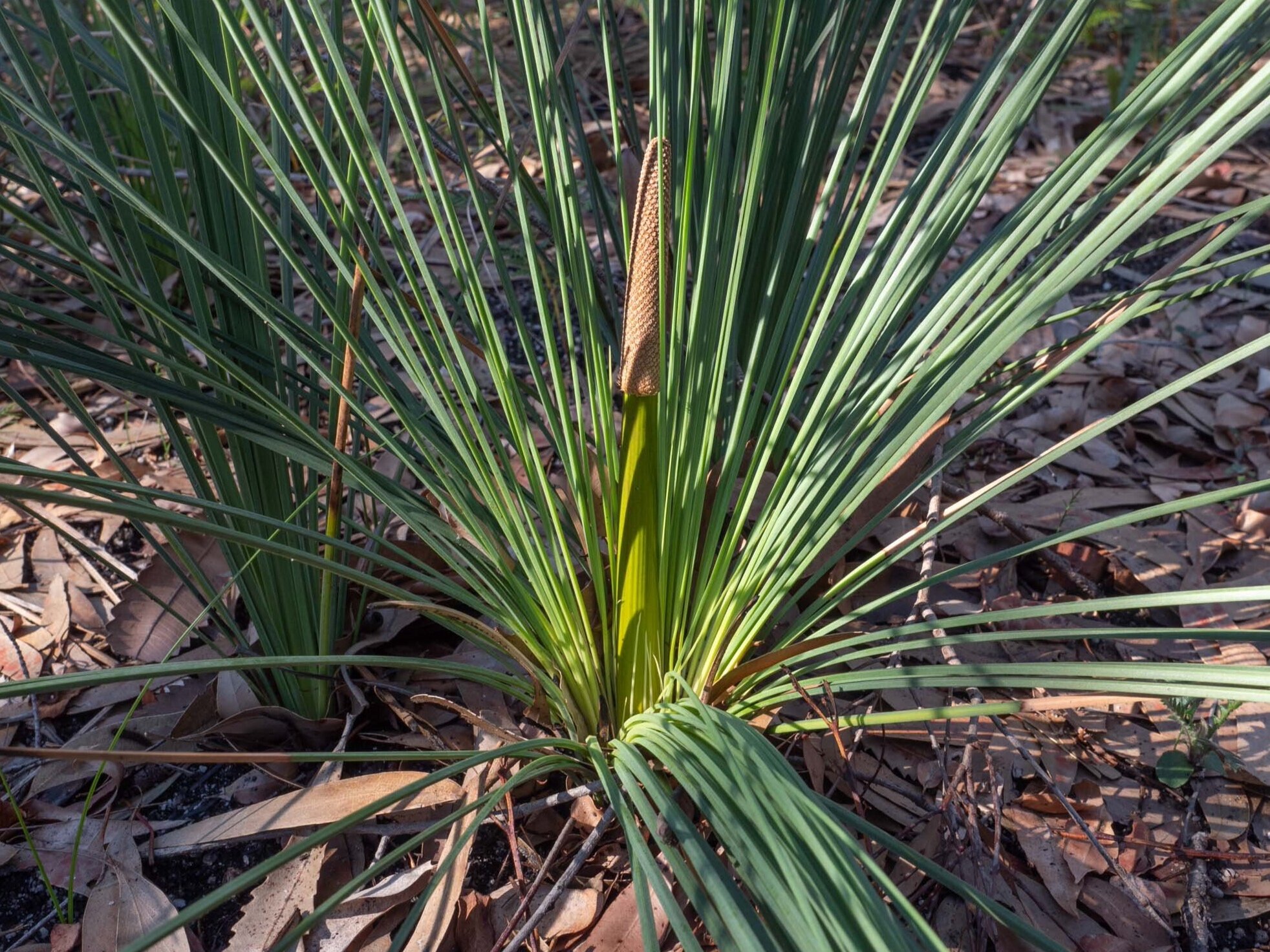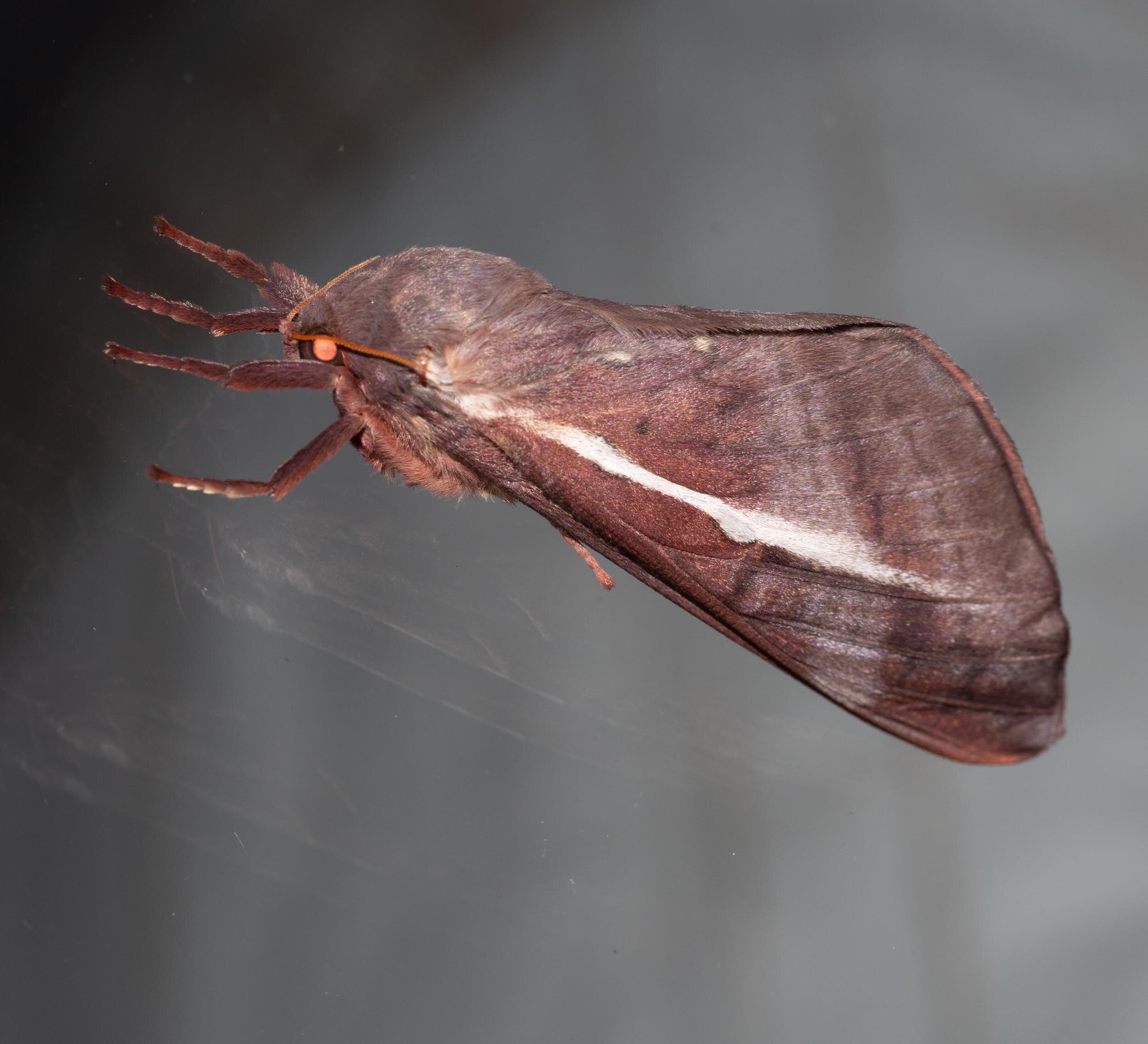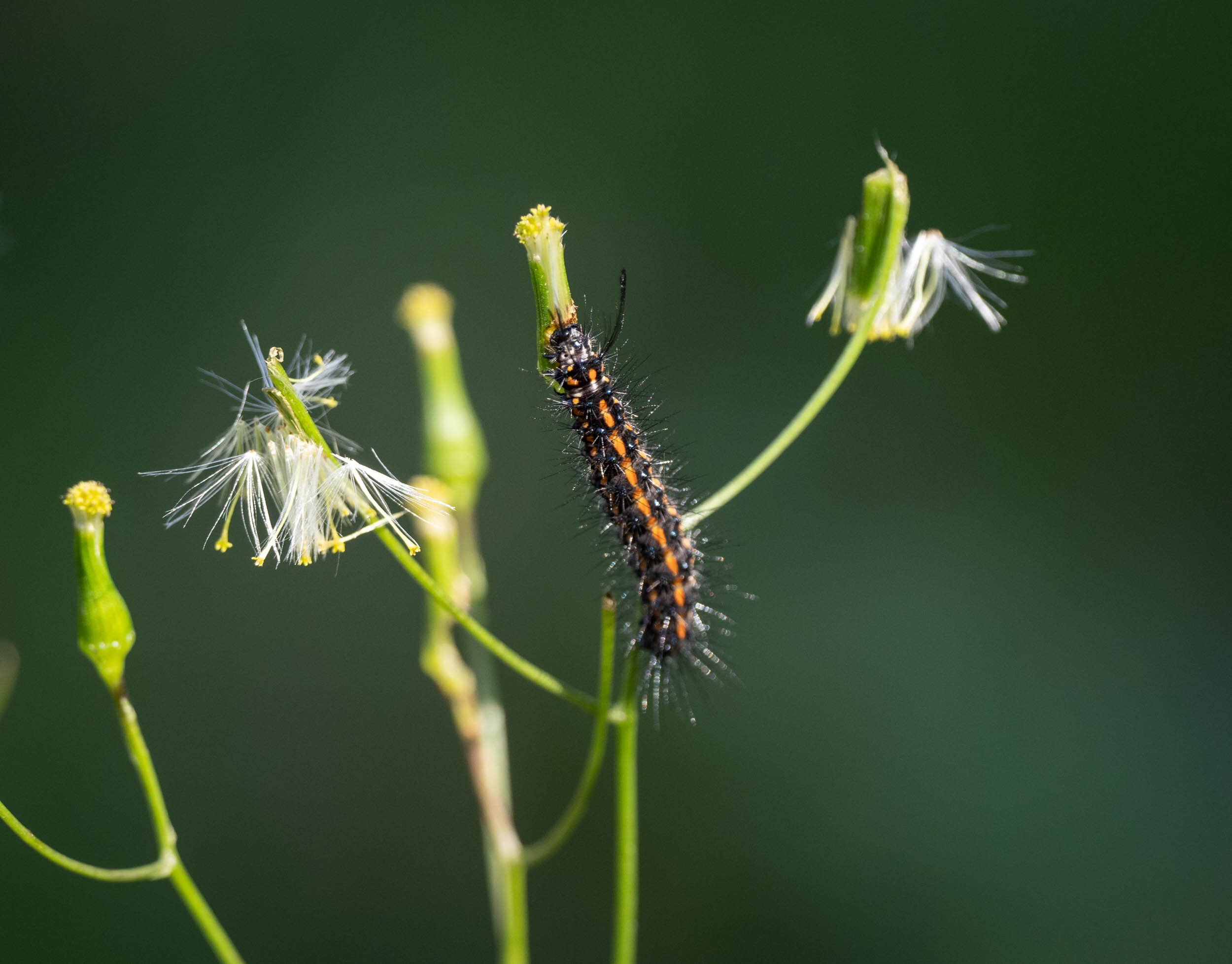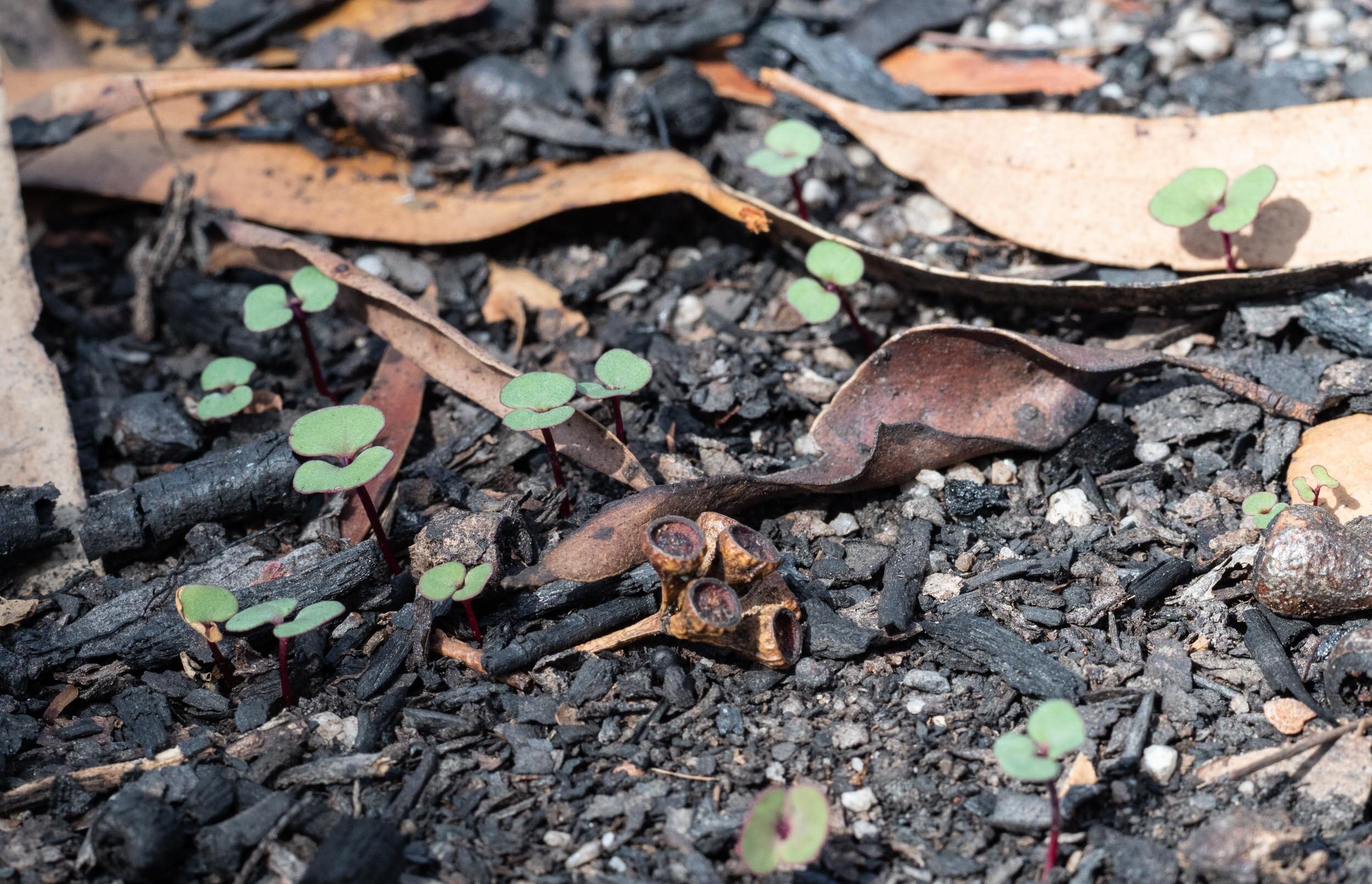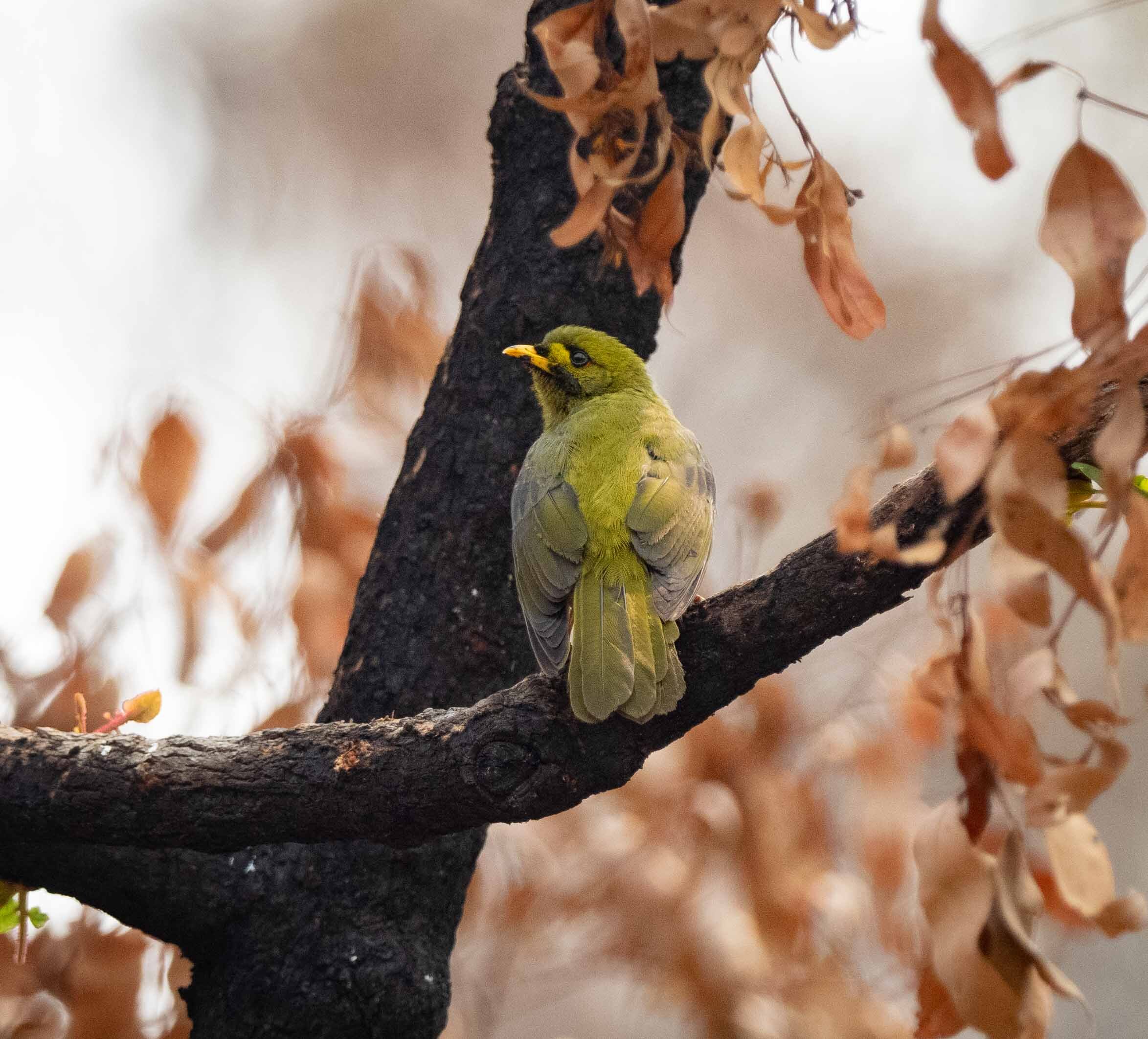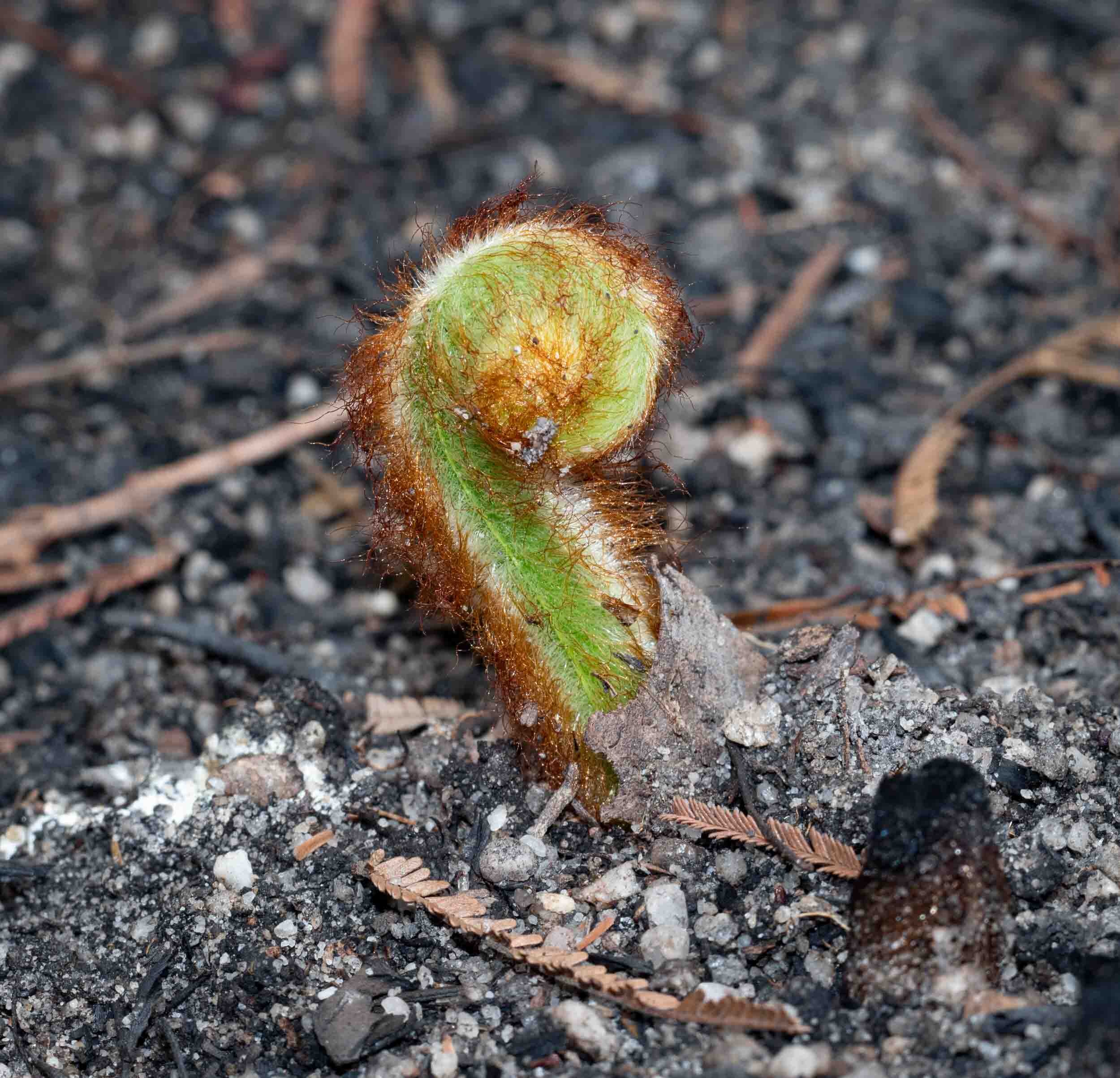Forest vegetation - another year on
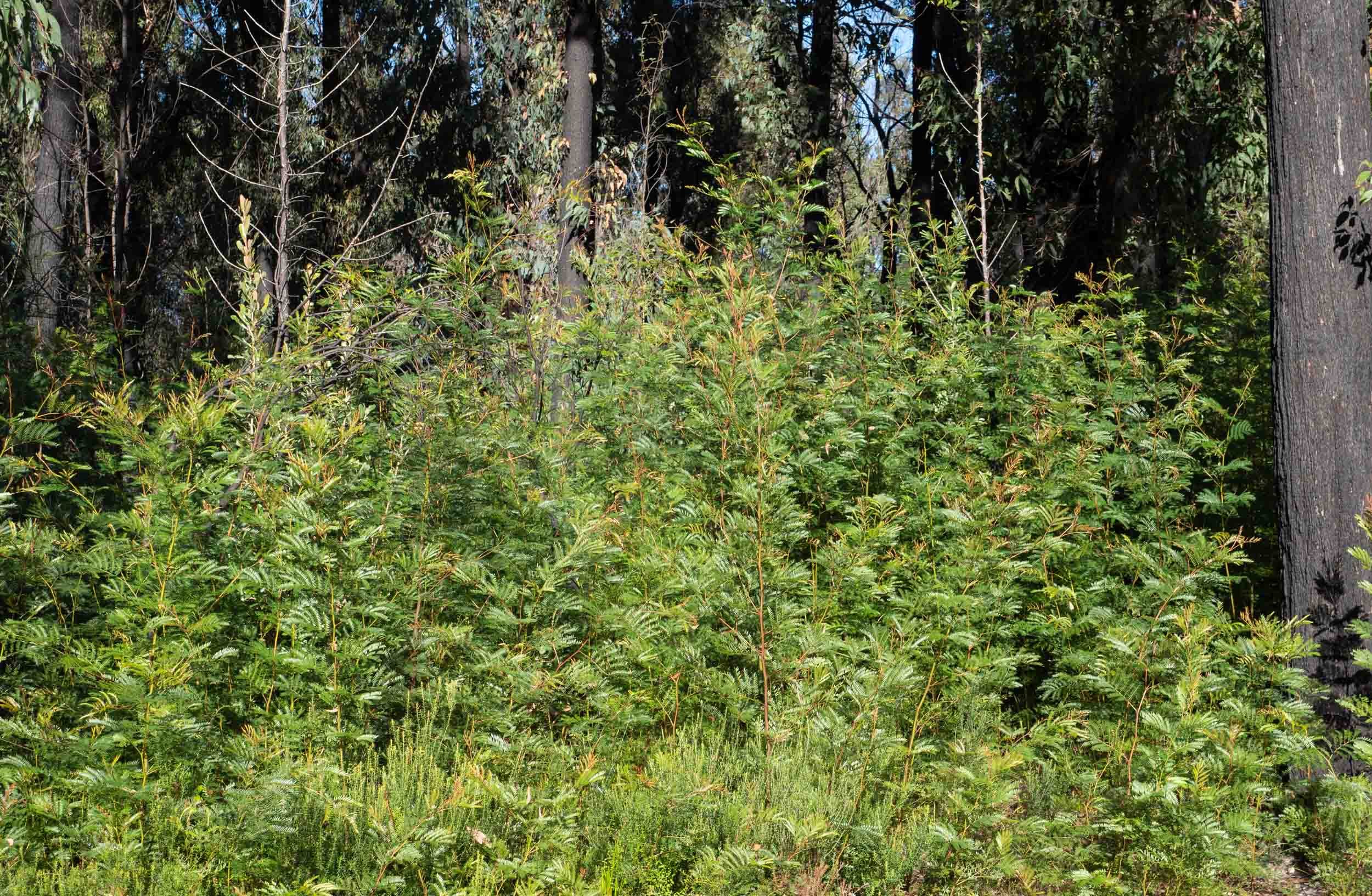
15 months after the Border Fire raced through our forest, the vegetation had made a dramatic recovery – a legacy of above average rainfall, a rich seed bed stored in the soil and the fertilizing effects of ash from the fire.
What difference has another year made?
Has the forest now returned to its pre-fire state?
Has it reached a new equilibrium or will it continue to change?
The middle storey has regenerated by degrees
Walls of wattles
A year ago, large patches of the forest were covered with young seedlings of four different wattle species – Sunshine Wattle (Acacia terminalis), Late Black Wattle (Acacia mearnsii), Sydney Golden Wattle (Acacia longifolia) and Blunt Leaf Wattle (Acacia obtusifolia). Growth of this key component of the middle storey was underway, but still at any early stage. Most of these seedlings were less than 1.5 metres tall.
Over the last 6 months, in response to high spring and summer rainfall, these wattles have grown dramatically. Some of the Late Black Wattles are now low trees – up to 5m tall – while many of the other species have attained a height of over 4m. The wattle groves are so dense in places as to be almost impenetrable - just like a jungle.
The following images show the growth of a particular grove of Sunshine Wattle after the fire.
25th January 2020 - 15 days post fire. The entire middle storey and undergrowth has been razed.
7th April 2021. Many small Sunshine Wattle bushes are present in the foreground.
9th August 2021 - part of the same Sunshine Wattle grove 4 months later. The seedlings have grown slowly over the winter. As a reference, the young kangaroo stands about 1 metre tall.
14th May 2022. The same Sunshine Wattle bushes have grown dramatically over the following 9 months. A reference kangaroo stands in the lower right foreground.
Other middle-storey species elsewhere in the forest – such as Austral Indigo (Indigofera australis), Blue Oliveberry (Elaeocarpus reticulatus), Narrow-leaf and Smooth Geebung (Persoonia linearis and Persoonia levis) and Large-leaf Hopbush (Dodonaea triquetra) – have also put on a burst of growth. Some of these have regenerated from the rootstock of burnt bushes; others have regrown from seed.
The following pair of images shows the explosive regrowth of Large-leaf Hopbush (Dodonaea triquetra) plants in one location.
18th August 2021 - 19 months post fire
13th May 2022 - the same area 9 months later. The light green Large-leaf Hopbush (Dodonaea triquetra) plants dominate the foreground. This species sprouted profusely over large areas of the forest after the fire.
The middle storey has regenerated much faster than we expected. Does this wall-to-wall growth of wattles and other middle storey plants represent the ‘new normal’ for our forest? Or will these dense groves of vegetation thin out over time? Changes in vegetation that occurred well before the fire struck give us a likely answer.
Regeneration and senescence before the fire
A grove of Sunshine Wattle appeared a few years after we purchased our block in 2004 in the same area as the wattles shown in the group of 4 photos above. These bushes had regenerated following slashing of the middle storey prior to 2004. They grew steadily, flowered and produced fruit over several seasons - seed pods which were a favoured food of visiting Gang-gang Cockatoos.
All of these plants subsequently withered and died, about 8-9 years after they had first appeared. This is consistent with reports of the limited life span of this wattle species (ref. 1).
Before they died, those bushes dropped seed into the soil, which germinated after the fire to produce the wall of wattle we see in that position today. Germination of Sunshine Wattle is known to require exposure to temperatures over 60°C (ref. 1), so the reappearance of this grove was dependent on the bushfire event. Destruction is part of the arsenal for regeneration.
It seems very likely that the dense stand of Sunshine Wattle bushes present now will quickly thin out over the coming years, as these plants naturally senesce. Change will continue.
Here’s more evidence of the dynamic nature of the forest ecosystem.
Change in a new post-fire community
In the 12 months after the fire, a completely new mix of vegetation developed on the slopes leading down to the Wonboyn River.
The rampant growth of a range of plants – notably Green Kangaroo Apple (Solanum vescum), Large-leaf Hopbush, Forest Groundsel (Senecio velleioides), Hop Goodenia (Goodenia ovata) and young seedlings of Blunt Leaf Wattle (Acacia obtusifolia)– converted this previously sparsely vegetated, rocky site into another ‘jungle’.
We had never seen Green Kangaroo Apple or Forest Groundsel in the forest before the fire. The other plant species in that newly emergent community had been present but in much lower numbers.
The Green Kangaroo Apple grew to be 1.5m tall, thick-stemmed, broadly spreading bushes. They flowered heavily last spring and many bore fruit. Then, quite dramatically, within just a few months, every single one of those plants died.
This occurred in bushes located in widely separated sites in the forest, suggesting that it was the result of a short natural lifespan of this species – rather than unsuitable local growth conditions.
The remaining plant species in this river slopes community have continued to grow strongly.
The Large-leaf Hopbush (Dodonaea triquetra) plants are now waist high. Blunt Leaf Wattle seedlings (Acacia obtusifolia), like those of other wattles in the forest, have thrust upwards to heights of 3 metres and more.
Additional species, including Black She-oak (Allocasuarina littoralis), Bracelet Honey-myrtle (Melaleuca armillaris), Cherry Ballart (Exocarpos cupressiformis) and Willow Needlewood (Hakea macraeana) have appeared, growing from seed released by trees that were killed in the fire or from their rootstock.
Nodding Blue Lily (Stypandra glauca), a species we knew before the fire from a just a handful of low-growing forbs in a single cliff top location, is now growing profusely on the slopes.
In places, it forms dense thickets of vegetation over a metre tall.
Nodding Blue Lily (Stypandra glauca)
So this part of the forest has undergone rapid change and it is continuing. It’s likely that these river slopes will look very different next autumn.
A spectacular renaissance of the undergrowth
The first spring after the fire heralded a burst of flowering of forbs at an intensity we’d never previously witnessed.
Some of these forbs – such as Toothed Lobelia (Lobelia dentata), Red Passionflower (Passiflora cinnabarina), Autumn Wasp Orchid (Chiloglottis curviclavia), Wallflower Donkey Orchid (Diuris orientis), Small Tongue Orchid (Cryptostylis leptochila), Fairy Fan-Flower (Scaevola aemula) and Wonga Wonga Vine (Pandorea pandorana) – had never appeared in the forest before.
A high percentage of our known species of forbs flowered in that first spring after the fire – a few of which feature below. Flowering was much more intense than normal, as measured both by the number of flowers of a given species and their spread over the forest.
One of these species, Holly Lomatia (Lomatia ilicifolia), only flowers after fire, so their blooms were a novel sight for us.
We had observed flowering of the Grasstrees (Xanthorrhoea concava) before, but in a typical year in the past only 3-4 of the hundreds of plants in the forest produced flowering spikes. The flowering display of this species in that first spring after the fire was outrageous!
29th October 2020. Just a small portion of the sea of the estimated 1,500 Grasstree spikes seen after the fire.
Flowering of grasstrees is heavily dependent on exposure to fire. There were more spikes in this one clump than we’d normally see in the whole forest.
The post-fire response of almost all of our ~20 home native grass species and ~10 sedge and rush species was just as dramatic as that of the forbs. There were many more individual plants, tufts were larger, culms were much taller and inflorescences were denser than normal.
Red-anther Wallaby Grass (Rytidosperma pallidum) and Kangaroo Grass (Themeda triandra), which in previous years had been seen only occasionally or in just a few locations, flowered exuberantly and broadly across the forest.
While Sheath Sedge (Cyathochaeta diandra) was well represented in the forest before the fire, these plants showed dramatic vegetative growth thereafter and, for the first time, produced flowering culms.
This strong recovery of forbs and grasses can be attributed to the same factors that promoted growth of the middle storey plants - high rainfall, a boon of minerals from the ash and extra sunlight resulting from the sparse canopy.
In addition, plants in the undergrowth faced less competition for all of these resources because the middle storey was only a shadow of its former self in the first year.
Undergrowth change in the second year
Unusually high rainfall (520mm) between September 2020 and February 2021 promoted rampant vegetative growth of many species of forbs – particularly in more open areas of the forest. Previously small patches of vegetation became large beds.
This resulted in a sensational flowering display of these forbs in the following spring – the second after the fire. The diversity and density of the flowers in those areas – evident in the following panel of photos taken in mid spring 2021 – gave them the appearance of a planted garden.
The panel below shows some of the species that featured prominently in these displays. Can you find them in the above images?
Some of the new forbs we saw in the first spring after the fire failed to reappear in the second year (e.g. Wonga Wonga Vine, Pandorea pandorana; Toothed Lobelia, Lobelia dentata; Autumn Wasp Orchid, Chiloglottis curviclavia; Small Tongue Orchid, Cryptostylis leptochila). And some of the familiar species that flowering strongly in the first year made a more muted display in the second year.
To balance the ledger, several novel species for the forest (e.g. Notched Bush-pea, Pultenaea retusa; Pultenaea linophylla) were sighted in the second spring and some of our known species flowered for the first time since the fire (e.g. Large-leaf Bush-pea, Pultenaea daphnoides; Lesser Guinea Flower, Hibbertia calycina; Bundled Guinea Flower, Hibbertia fasciculata; Hibbertia empetrifolia empetrifolia).
Long-leaved Wallaby Grass (Rytidosperma longifolium) 16/12/21
With just a few exceptions (e.g. Long-leaved Wallaby Grass, Rytidosperma longifolium; Fine-leaved Snow Grass, Poa meionectes), flowering of grasses was much less intense in the second spring/summer after the fire than in the first year.
For any given species, fewer flowering plants were seen and these were more restricted in their range.
This was particularly noticeable for Red-anther Wallaby Grass (Rytidosperma pallidum) and Kangaroo Grass (Themeda triandra), which had shown such a dramatic range extension in the first summer. Just a handful of flowering tufts of both of these species were sighted in the second summer vs. dozens in the first year.
In contrast, the second post-fire summer saw strong vegetative growth and flowering of Thatch Saw-Sedge (Gahnia radula). Large areas of the forest are now dominated by this species and in places its culms reach to chest height.
Thatch Saw-Sedge (Gahnia radula) 17/5/22
What has been responsible for these changes in the undergrowth in the last year?
Undoubtedly, a more intense level of competition between plants for water and nutrients has played a role as the previously empty forest floor has become rapidly populated. Sunlight has also become a scarcer resource as the canopy and middle storey have gradually filled in.
Another major influence on the forest plants are the herbivores - both invertebrate and vertebrate. Our resident Red-necked Wallaby (Macropus rufogriseus) population has increased greatly in the last year. They are certainly doing their bit to trim back the rampant undergrowth!
Where’s the bracken?
Typically, following a forest fire, there is an explosive growth of Austral Bracken (Pteridium esculentum). It came as a surprise that this did not occur in our forest.
Bracken was one of the first plants to show signs of regeneration, sprouting from rhizomes within weeks of the fire.
These young plants grew vigorously for a time, but then started to look unhealthy before largely dying back. Nearby plants of other species generally appeared quite healthy.
This dieback continues to occur to this day.
Bracken is now much less common than before the fire. It’s unclear what has caused this change, which we’ve observed throughout the forest.
dead and dying Bracken fronds 19/5/22
Rainbow Fern (Calochlaena dubia) 19/5/22
Rainbow Fern (Calochlaena dubia) is similar in appearance to and often confused with Bracken but is actually unrelated to it.
Rainbow Fern is a close relative of tree ferns. In contrast to Bracken, Rainbow Fern is growing vigorously all over the forest.
What’s next?
We’ve seen major changes in the forest vegetation as it has regenerated after the fire. Some of these have been gradual, others quite rapid. Seasonal changes have differed between the first and second post-fire years.
The forest we see now is quite different in many respects to the one we knew before the fire. But we think it’s unlikely that we’ve arrived at a new stable state, which will persist into the future.
Environmental factors affecting plant growth – nutrients, light and water and competition between plants for access to these – will continue to change as the forest regenerates further. Changes in climate, both in the medium and long term, are virtually guaranteed and these will drive changes in the vegetation.
Ecosystems are never static!
References:
Bremner, M. and Goeth, A. 2010. “Acacia terminalis ssp. terminalis (Sunshine Wattle) National Recovery Plan.” Department of Environment, Climate Change and Water NSW. (https://www.awe.gov.au/sites/default/files/documents/acacia-terminalis-terminalis.pdf)
























